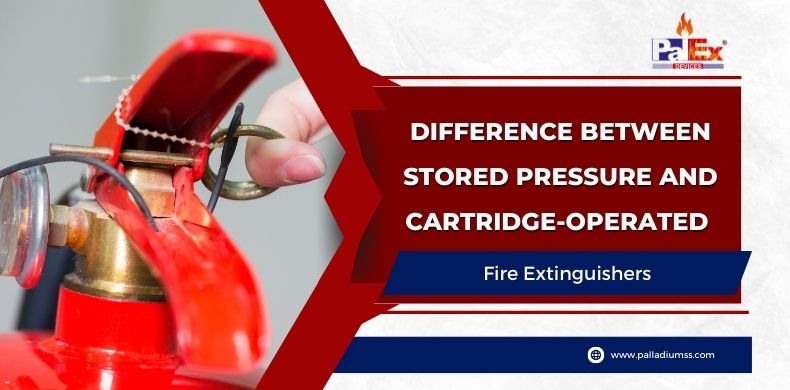Fire extinguishers are primarily designed in two different ways according to how they release their fire suppressant: the stored pressure type and the cartridge operated fire extinguisher type. These designs illustrate fundamentally distinct strategies for creating pressure that is necessary to effectively use a fire suppressant during an emergency situation with flames.
How Stored Pressure Fire Extinguishers Work
The design of stored pressure is what you usually find in homes and places of work. This setup keeps both the putting out fire substance along with the gas that pushes it (often nitrogen) inside one cylinder as a single unit. Inside this extinguisher, there’s always maintained pressure making it prepared for instant use whenever required.
Fire extinguishers that work with stored pressure and those operated by a cartridge are different in their build. For models of the stored pressure, they come with a gauge for checking the pressure status just by looking at it. This gauge is very important because it shows if there is enough pressurization within the extinguisher to function well when there’s need for its use during an emergency situation.
Also read : Revolutionizing Fire Safety with Technology: From Smart Sensors to Automated Firefighting Equipment
How Cartridge-Operated Fire Extinguishers Work
Cartridge-type extinguishers have a different method. They keep the extinguishing substance in their main body and store the gas used to release it in another small cartridge. When you trigger this extinguisher, the tiny cartridge is cracked open. This releases compressed gas into its main part, pushing out the substance that puts out fire.
The gap between the agent and propellant in a stored pressure and cartridge run fire extinguisher results in unique operational qualities. Cartridge-run types do not need a pressure gauge because, until activation, the propellant does not come into contact with the extinguishing agent.
Maintenance Differences
The needs for upkeep can differ greatly between stored pressure and cartridge activated types of fire extinguishers. Those with stored pressure need frequent checks on their pressure because they may slowly lose it over a period due to tiny leaks. If the pressure drops under working levels, usually the whole unit will need professional re-charging.
Models that operate with cartridges bring benefits in terms of upkeep. As the propellant is kept within the cartridge until it’s required, there are less worries about losing pressure as time goes by. Furthermore, many models can be filled up on-site after they’re used just by swapping out the extinguishing substance and the expelling cartridge.
Also read : Benefits of Installing Fire Sprinklers in Residential and Commercial Buildings
Performance Considerations
When we look at how they perform, stored pressure and cartridge operated fire extinguisher types each come with their own benefits. Models of stored pressure provide readiness immediately and are easier to operate. The design they hold needs less steps for activation; this can be very important in a stressful fire emergency situation.
Models of cartridge might need an additional step for activation, but usually provide steady pressure during the process of discharge. This may lead to a better delivery of agents, particularly in bigger models that are used for applications in industry.
Choosing the Right Type
The selection of these extinguisher kinds is reliant on particular requirements. The stored pressure models are usually more economical and appropriate for many residential and minor business settings. Their easy-to-use nature makes them available to unskilled individuals.
In industries, marine uses and severely weathered areas, people often choose extinguishers that operate with cartridges. They store the expellant and agent separately which gives them better performance in rough conditions. Also, it makes their care easier in far-off places.
Comprehending the variations between these two patterns assists in making knowledgeable choices about fire safety apparatus selection based on particular environmental needs and maintenance abilities.
Related blog :
Evaluation Factors to Choose the Top Fire Protection Companies
Do Not Keep Your Fire Escape Plans a Secret
10 Common Fire Extinguisher Mistakes You Should Avoid
Warehouse Fires – A Nightmare for a Business



